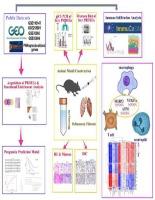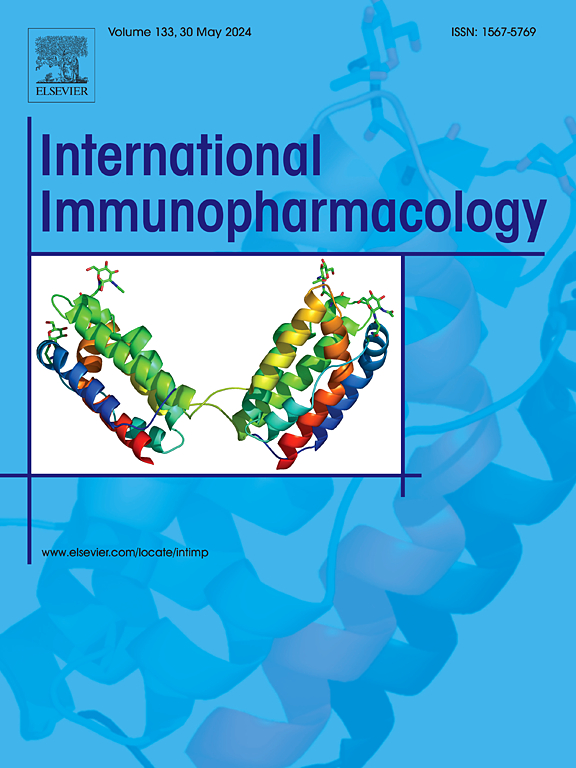Molecular characterization of PANoptosis-related genes associated with immune infiltration and prognosis in idiopathic pulmonary fibrosis
IF 4.7
2区 医学
Q2 IMMUNOLOGY
引用次数: 0
Abstract
Idiopathic pulmonary fibrosis (IPF) is a chronic pulmonary disease with unknown pathogenesis and poor prognosis. PANoptosis, a newly identified form of inflammatory programmed cell death, has been implicated in various inflammatory lung diseases. This study aimed to identify differentially expressed PANoptosis-related genes (PRDEGs) associated with immune infiltration and prognosis in IPF, while also establishing a novel prognostic prediction model. A total of 63 PRDEGs were identified from GSE110147 dataset, with 31 exhibiting consistent expression trends in GSE213001. Enrichment analysis indicated that the majority of these PRDEGs were enriched in inflammatory and immune-related pathways. Three key PRDEGs—NLRP3, ATM, and VEGFA—were selected through univariate and multivariable Cox regression analyses. The prognostic prediction model developed from these key PRDEGs demonstrated robust predictive performance. Furthermore, the expression of most PRDEGs was positively correlated with pro-inflammatory immune cells, including macrophages, neutrophils, and CD4+ T cells. Validation of the expression levels of these key PRDEGs was conducted in fibrotic mouse lung tissue. This study suggests that PANoptosis plays a role in IPF, potentially linked to the infiltration of pro-inflammatory immune cells, and may influence disease progression through the regulation of inflammatory immune signaling pathway. A new prognostic prediction model for IPF based on PRDEGs was successfully developed.

与特发性肺纤维化免疫浸润和预后相关的 PANoptosis 相关基因的分子特征。
特发性肺纤维化(IPF)是一种发病机制不明、预后不良的慢性肺部疾病。PAN凋亡是一种新发现的炎症性程序性细胞死亡形式,与多种炎症性肺部疾病有关。本研究旨在鉴定与 IPF 免疫浸润和预后相关的 PANoptosis 相关差异表达基因(PRDEGs),同时建立一个新的预后预测模型。从 GSE110147 数据集中共鉴定出 63 个 PRDEGs,其中 31 个在 GSE213001 中表现出一致的表达趋势。富集分析表明,这些PRDEG大多富集在炎症和免疫相关通路中。通过单变量和多变量考克斯回归分析,选出了三个关键的 PRDEGs-NLRP3、ATM 和 VEGFA。根据这些关键PRDEG建立的预后预测模型显示出强大的预测性能。此外,大多数 PRDEGs 的表达与促炎免疫细胞(包括巨噬细胞、中性粒细胞和 CD4+ T 细胞)呈正相关。在纤维化小鼠肺组织中对这些关键 PRDEGs 的表达水平进行了验证。这项研究表明,PANoptosis 在 IPF 中发挥作用,可能与促炎症免疫细胞的浸润有关,并可能通过调节炎症免疫信号通路影响疾病的进展。基于 PRDEGs 的 IPF 预后预测模型已成功开发出来。
本文章由计算机程序翻译,如有差异,请以英文原文为准。
求助全文
约1分钟内获得全文
求助全文
来源期刊
CiteScore
8.40
自引率
3.60%
发文量
935
审稿时长
53 days
期刊介绍:
International Immunopharmacology is the primary vehicle for the publication of original research papers pertinent to the overlapping areas of immunology, pharmacology, cytokine biology, immunotherapy, immunopathology and immunotoxicology. Review articles that encompass these subjects are also welcome.
The subject material appropriate for submission includes:
• Clinical studies employing immunotherapy of any type including the use of: bacterial and chemical agents; thymic hormones, interferon, lymphokines, etc., in transplantation and diseases such as cancer, immunodeficiency, chronic infection and allergic, inflammatory or autoimmune disorders.
• Studies on the mechanisms of action of these agents for specific parameters of immune competence as well as the overall clinical state.
• Pre-clinical animal studies and in vitro studies on mechanisms of action with immunopotentiators, immunomodulators, immunoadjuvants and other pharmacological agents active on cells participating in immune or allergic responses.
• Pharmacological compounds, microbial products and toxicological agents that affect the lymphoid system, and their mechanisms of action.
• Agents that activate genes or modify transcription and translation within the immune response.
• Substances activated, generated, or released through immunologic or related pathways that are pharmacologically active.
• Production, function and regulation of cytokines and their receptors.
• Classical pharmacological studies on the effects of chemokines and bioactive factors released during immunological reactions.

 求助内容:
求助内容: 应助结果提醒方式:
应助结果提醒方式:


